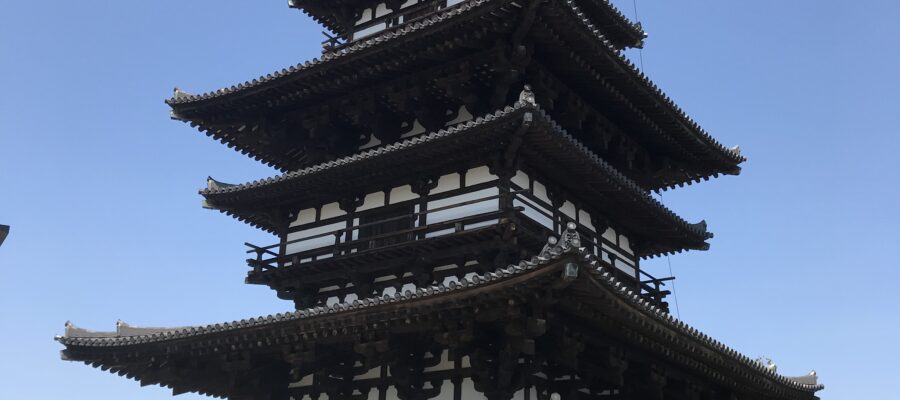東塔の心柱を一般公開
ゴールデンウィークを家でゆっくり過ごそうと思っていたところ、ローカルニュースで薬師寺が紹介されていました。解体修理を終えた東塔の内部を一般公開しているそうで、心柱を肉眼で見られるそうです。そして、今回のチャンスを逃すと、次回見られるのは、いつになるかわからないと言うことで、50代の私としては最後の機会かも知れないと思い、心柱を見に行くことにしました。
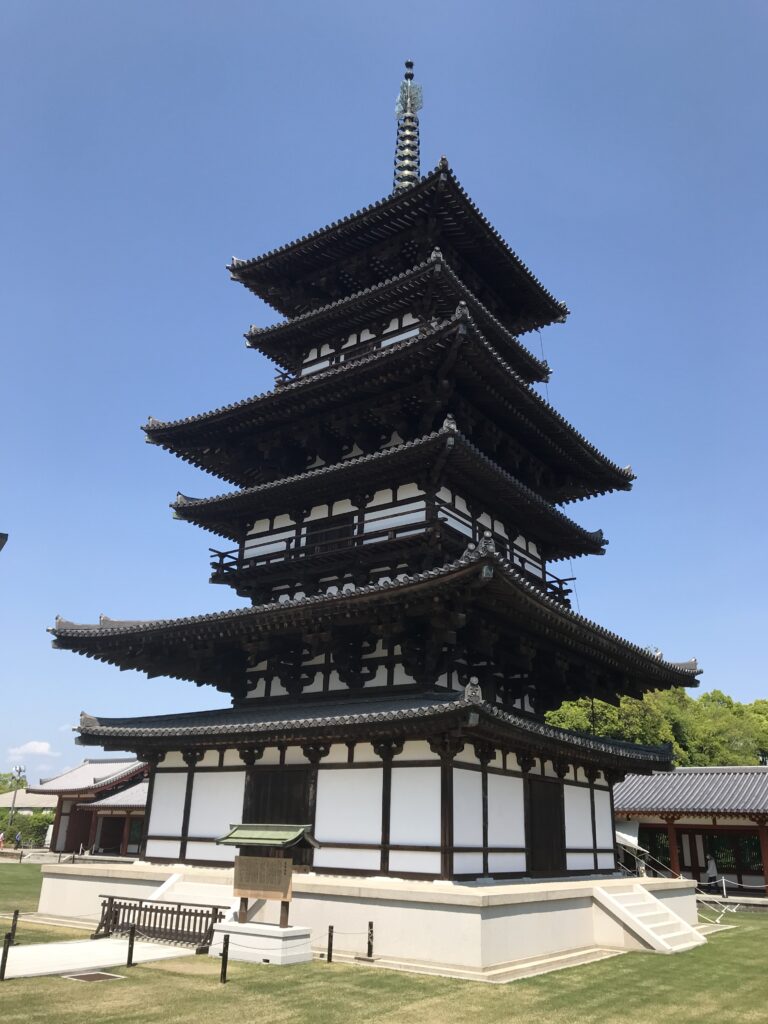
薬師寺に行くのは3年ぶりかも知れません。前回は日本で学ぶ留学生をお連れしましたが、今回は妻と二人で近鉄電車に乗って向かいました。東塔を見る前に、東院堂で国宝の聖観音像を拝見しました。目立たないところに国宝があるのも奈良のお寺という感じがします。
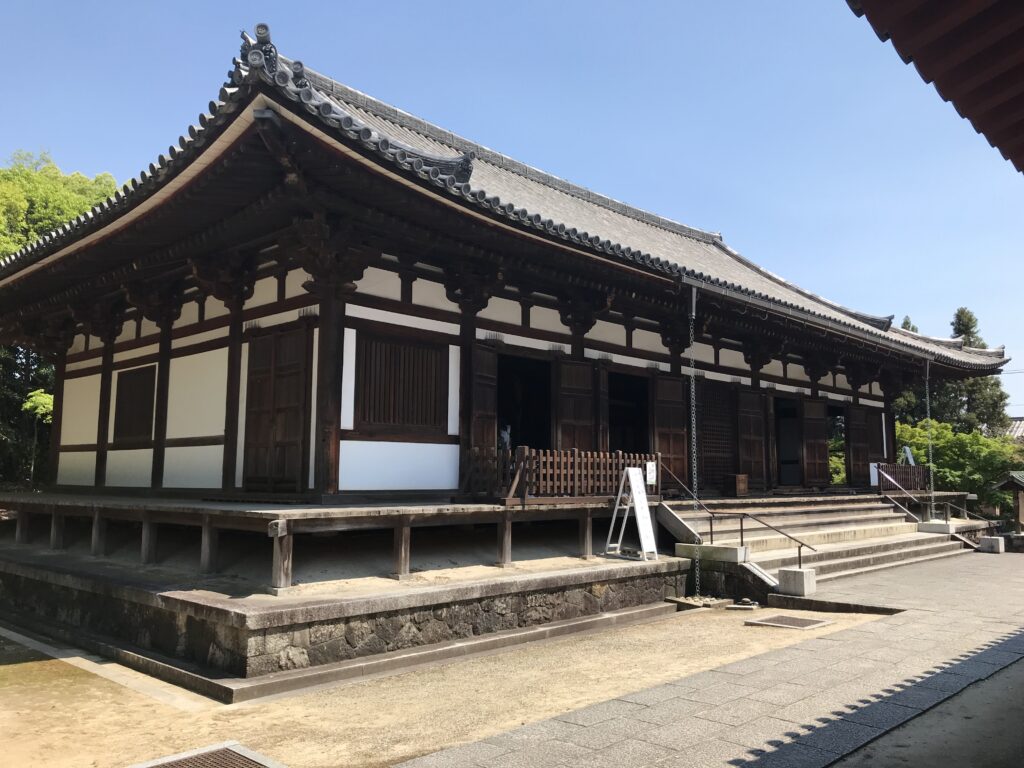
東塔の前には行列ができていました。塔の中は薄暗く、当日は晴天のためか、間近まで行かないと何も見えません。塔内部は撮影禁止なので、写真をお見せすることはできませんが、1300年の時を経た心柱を、この目で見ることができました。また、東塔の最上部に設置されていた水煙も西僧坊にて展示されているのを見学しました。感動というよりも、一仕事終えたという充実感がありました。
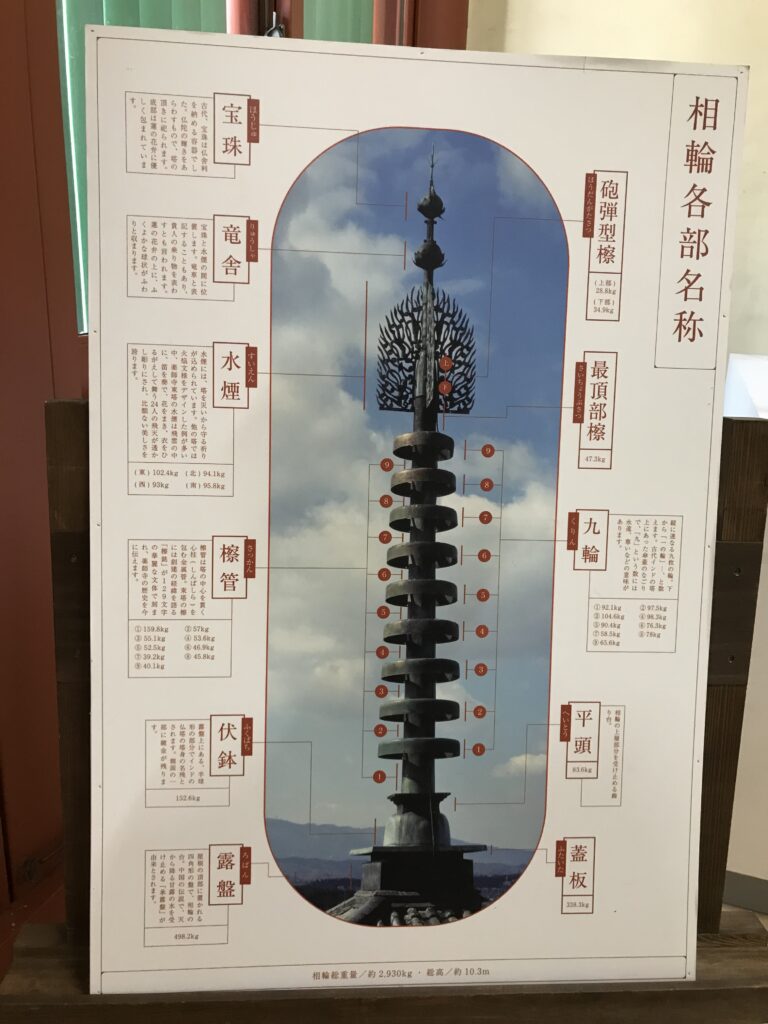
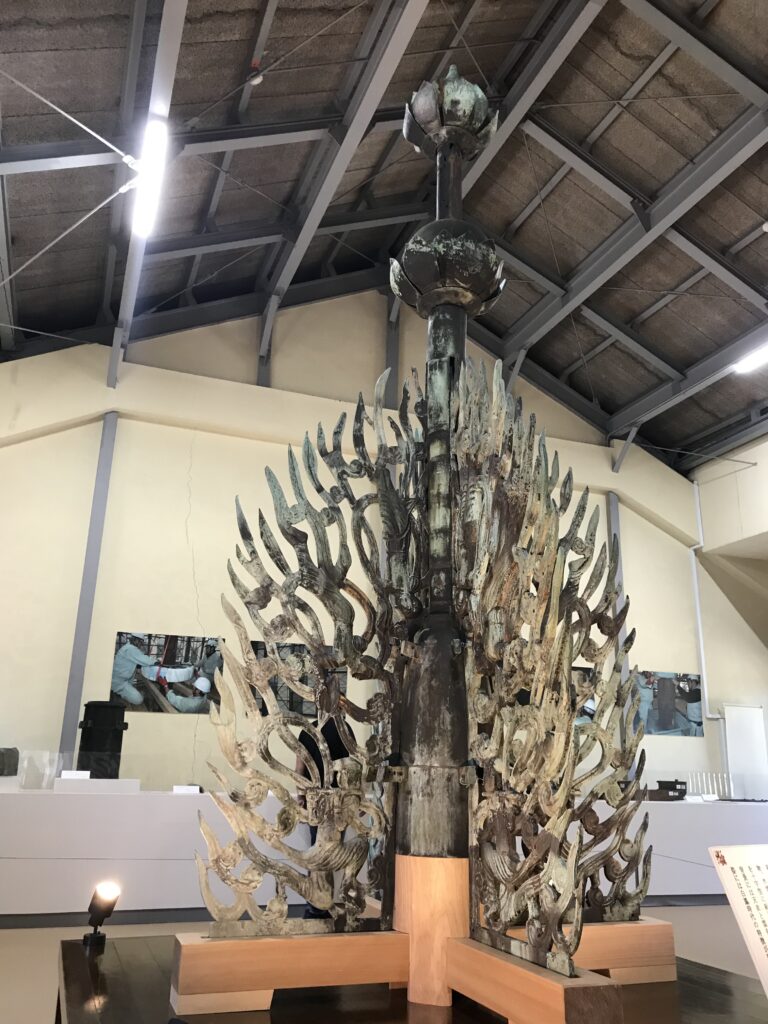
西国四十九薬師霊場めぐりを開始
その後、金堂で薬師如来像、日光菩薩像、月光菩薩像の3尊像を拝んできました。何度見ても、ここの薬師三尊は素晴らしい仏像です。黒光した仏像に1300年の歴史を感じます。像の裏側に回って、仏足石と本尊の台座を間近で見てきました。台座のレプリカは東僧坊に置いてありますが、やはり本物を見ないと来た意味がありません。裏側の1面しか見えないのですが、悠久の歴史と、東西文化交流を象徴するデザインを堪能しました。
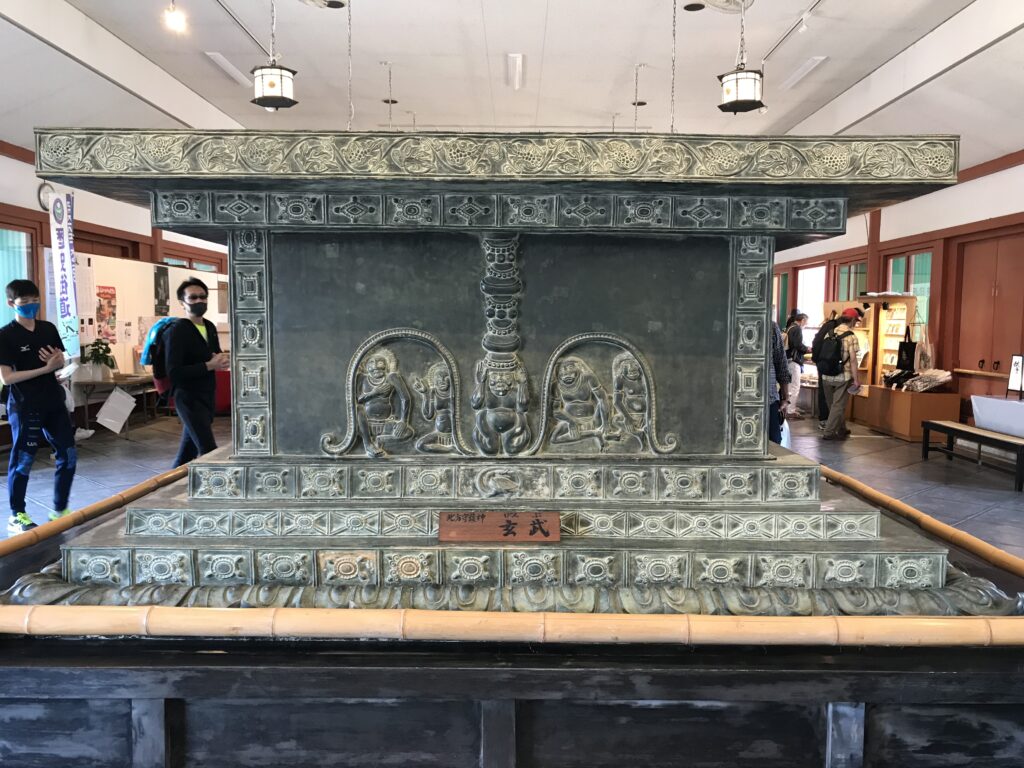
今回、訪問前に調べたところ、「西国四十九薬師霊場めぐり」の第1番が薬師寺であることを知りました。バインダーに綴じる用のご詠歌付きの御朱印を記した紙をいただけるそうで、まずはバインダーを購入し、薬師寺の御朱印をいただきました。バインダー式なので、少し大きめですが、無理せず四十九ヶ所の内、近場のお寺は回ってみようと思います。ただ、いくつかのお寺は新西国三十三霊場と重なっているようです。
もちろん、四十九霊場の中には、まだ訪問したこともないお寺もありますので、どのような薬師如来像に会えるか楽しみです。
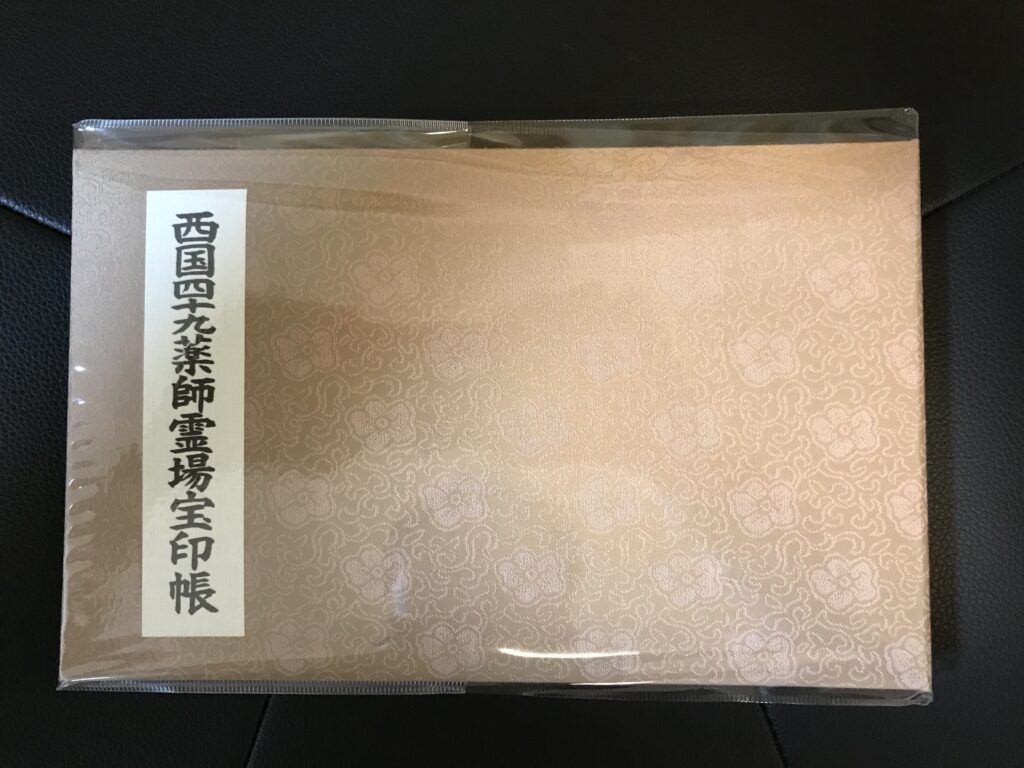
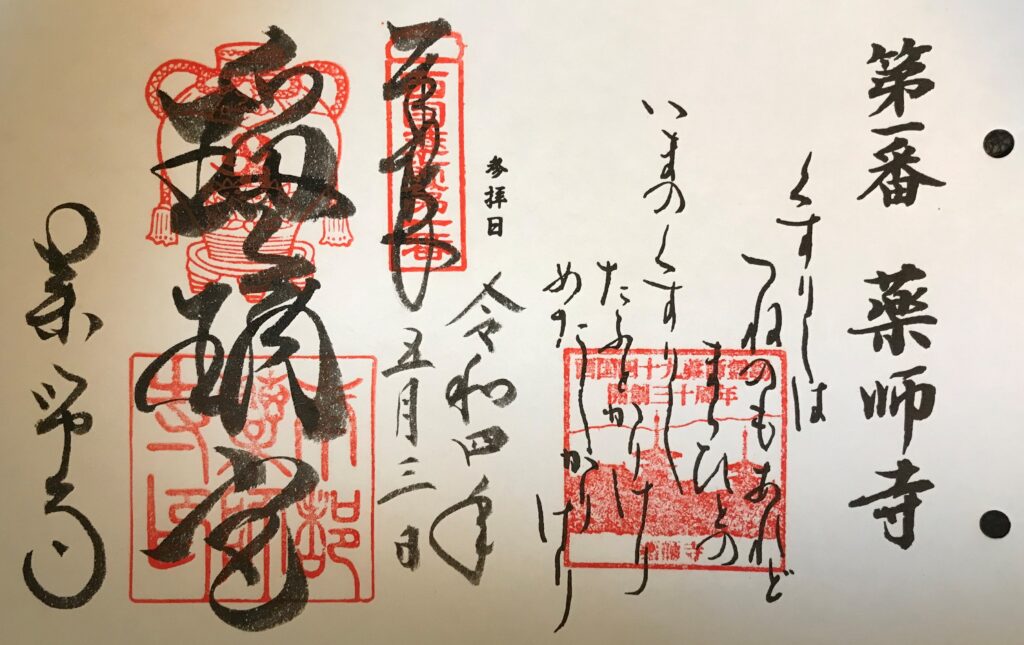
初心者が学びやすい仏像を解説した書籍
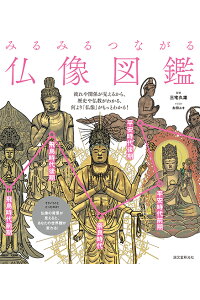
みるみるつながる仏像図鑑 流れや関係が見えるから、歴史や仏教がわかる、何より「仏像」がもっとわかる! [ 三宅 久雄 ]
価格:1,760円
(2021/9/11 11:28時点)
感想(0件)
Yakushiji Temple (2) Central Pillar of the East Pagoda
While I was planning to spend Golden Week relaxing at home, Yakushiji Temple was introduced on the local news. It is said that the interior of the east pagoda, which has been dismantled and repaired, is now open to the public, and you can see the central pillar with the naked eye. I decided to go see the Shinbashira central pillar, thinking that it might be my last chance to see it as I am in my fifties.
It may have been three years since I visited Yakushiji Temple. Last time I took a foreign student studying in Japan with me, but this time my wife and I took the Kintetsu train to go there. Before seeing the East Pagoda, we went to Toindo to see the National Treasure, the statue of the Holy Kannon (Goddess of Mercy). It is a typical Nara temple to have a national treasure in an inconspicuous place.
There was a queue in front of the East Pagoda. The inside of the pagoda was dimly lit, and perhaps because it was a sunny day, you had to get up close to see anything. Photography is not allowed inside the pagoda, so I cannot show you any pictures, but I was able to see the 1300-year-old central pillar with my own eyes. We also saw the water smoke that was installed at the top of the East Pagoda on display at the West Monks’ Hall. Rather than being impressed, I felt a sense of fulfillment that I had completed a job.
After that, we went to Kondo to see the three statues of Yakushi Nyorai, Nikko Bosatsu (Sunlight Bodhisattva), and Gekko Bosatsu (Moonlight Bodhisattva). No matter how many times I see them, the three images of Yakushi Nyorai here are still wonderful Buddha images. The black shiny Buddha images remind us of 1300 years of history. I went around to the back side of the statues to get a closer look at the Buddha’s foot stone and the pedestal of the main statue. A replica of the pedestal is available in the East Monks’ Hall, but it would be meaningless to come without seeing the real thing. Although I could only see one side of the back side, I enjoyed the design that symbolizes the long history and the cultural exchange between East and West.
Before visiting the temple, I researched and learned that Yakushiji Temple is the first stop on the “49 Yakushi Sacred Sites in Western Japan” tour. We were told that we could receive a piece of paper with a red seal with a poem to bind it in a binder, so we first purchased a binder and received a red seal from Yakushiji Temple. Since it is a binder type, it is a bit large, but I will try to visit temples in the vicinity out of the 49 temples without straining myself. However, some of the temples seem to overlap with the new Saigoku 33 Sacred Sites.
Of course, there are temples among the 49 sacred sites that I have not yet visited, so I am looking forward to seeing what kind of Yakushi Nyorai statues I will be able to see. ( End )
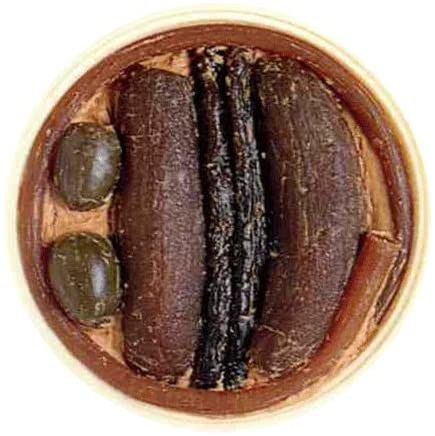
樽出し奈良漬け詰合せ N-80 (大森屋 漬物) お中元 お歳暮 ギフト
新品価格
¥8,640から
(2022/4/30 16:29時点)
Temple Yakushiji (2) Pilier central de la pagode Est
Alors que je prévoyais de passer la Semaine d’or à me détendre chez moi, le temple Yakushiji a été présenté aux informations locales. Il est dit que l’intérieur de la pagode orientale, qui a été démontée et réparée, est maintenant ouvert au public, et que l’on peut voir le pilier central à l’œil nu. J’ai décidé d’aller voir le pilier central de Shinbashira, pensant que c’était peut-être ma dernière chance de le voir, car j’ai la cinquantaine.
Cela fait peut-être trois ans que je n’ai pas visité le temple Yakushiji. La dernière fois, j’avais emmené avec moi un étudiant étranger qui étudiait au Japon, mais cette fois-ci, ma femme et moi avons pris le train Kintetsu pour nous y rendre. Avant de voir la pagode orientale, nous sommes allés à Toindo pour voir le trésor national, la statue de la sainte Kannon (déesse de la miséricorde). C’est un temple typique de Nara d’avoir un trésor national dans un endroit discret.
Il y avait une file d’attente devant la pagode orientale. L’intérieur de la pagode était faiblement éclairé, et peut-être parce que c’était une journée ensoleillée, il fallait s’approcher pour voir quelque chose. Il est interdit de photographier à l’intérieur de la pagode, je ne peux donc pas vous montrer de photos, mais j’ai pu voir de mes propres yeux le pilier central vieux de 1300 ans. Nous avons également vu la fumée d’eau installée au sommet de la pagode orientale, exposée dans la salle des moines de l’ouest. Plutôt que d’être impressionné, j’ai ressenti un sentiment de satisfaction d’avoir accompli un travail.
Ensuite, nous sommes allés à Kondo pour voir les trois statues de Yakushi Nyorai, Nikko Bosatsu (Bodhisattva du soleil) et Gekko Bosatsu (Bodhisattva du clair de lune). Peu importe combien de fois je les ai vues, les trois images de Yakushi Nyorai sont toujours de merveilleuses images de Bouddha. Les images de Bouddha noires et brillantes nous rappellent 1300 ans d’histoire. J’ai fait le tour de l’arrière des statues pour voir de plus près la pierre du pied du Bouddha et le piédestal de la statue principale. Une réplique du piédestal est disponible dans la salle des moines de l’est, mais il serait inutile de venir sans voir la vraie chose. Bien que je n’aie pu voir qu’un côté de la face arrière, j’ai apprécié le design qui symbolise la longue histoire et les échanges culturels entre l’Est et l’Ouest.
Avant de visiter le temple, j’ai fait des recherches et j’ai appris que le temple Yakushiji était la première étape du circuit “49 sites sacrés de Yakushi dans l’ouest du Japon”. On nous a dit que nous pouvions recevoir un morceau de papier avec un sceau rouge et un poème pour le relier dans un classeur. Nous avons donc d’abord acheté un classeur et reçu un sceau rouge du temple Yakushiji. Comme il s’agit d’un classeur, il est un peu grand, mais je vais essayer de visiter les temples des environs sur les 49 temples sans me fatiguer. Cependant, certains des temples semblent chevaucher les 33 nouveaux sites sacrés de Saigoku.
Bien sûr, il y a des temples parmi les 49 sites sacrés que je n’ai pas encore visités, alors j’ai hâte de voir quel genre de statues Yakushi Nyorai je pourrai voir. ( Fin )
